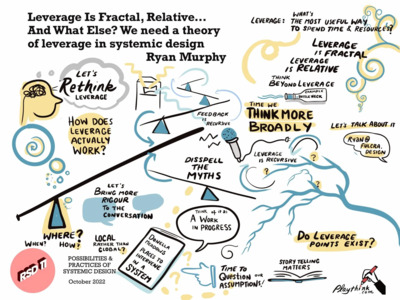Leverage Is Fractal, Relative… And What Else? We need a theory of leverage in systemic design
Murphy, Ryan J. A. (2022) Leverage Is Fractal, Relative… And What Else? We need a theory of leverage in systemic design. In: Proceedings of Relating Systems Thinking and Design, RSD11, 3-16 Oct 2022, Brighton, United Kingdom.
Preview |
Text
Murphy_Leverage_Paper_2022.pdf - Published Version Available under License Creative Commons Attribution Non-commercial No Derivatives. Download (152kB) | Preview |
Preview |
Slideshow
Murphy_Leverage_Slides_2022.pdf - Published Version Available under License Creative Commons Attribution Non-commercial No Derivatives. Download (1MB) | Preview |
![Sketchnote by Patricia Kambitch [thumbnail of Sketchnote by Patricia Kambitch]](https://openresearch.ocadu.ca/4348/3.hassmallThumbnailVersion/Murphy_Sketchnote_Image_2022.png)  Preview |
Image (Sketchnote by Patricia Kambitch)
Murphy_Sketchnote_Image_2022.png - Published Version Available under License Creative Commons Attribution Non-commercial No Derivatives. Download (2MB) | Preview |
Abstract
Donella Meadows’s 1997 “Places to Intervene in a System” is the cardinal resource on leverage points: places in a system where the littlest effort yields the greatest reward. As was her hallmark, Meadows’s treatment of leverage points was clear, concise, catchy, and constructive. Through storytelling and simple tables, she provided a compelling framework, ranking twelve types of leverage points in order of effectiveness. However, Meadows did not qualify her taxonomy of leverage points with much more than eloquent argument, feedback from colleagues, and her own experience. So, while the legacy of leverage points is certainly evidence that Meadows was on to something (published in Whole Earth Review, “Places to Intervene in a System” has been cited thousands of times), it is surprising that Meadows’s work has not been formally critiqued, validated, or advanced more since it was first published. Yet, as a result, the logics of leverage woefully lacks nuance. In her attempt to dispel the myths of leverage points, Meadows may have perpetuated their status even further, leaving a theory of leverage untouched for decades.
I call for novel, critical perspectives on leverage in systemic design. A deeper understanding of leverage and other features of systems will help systemic designers better understand the nature of systems and design better strategies for accelerating systems change. For example, in this presentation, I argue that Meadows’s “Places to Intervene in a System” fails to appreciate the fractal and relativistic nature of leverage. Leverage is fractal because we can find leverage points for leverage points. For instance, we can decompose systems phenomena into subsystems and search for leverage in these subsystems. Leverage is relative because someone’s power over a system depends on what they have the ability to influence directly. Thus, identifying a “local” leverage point may be more important than identifying the system’s “global” leverage points. I show how systemic designers can account for these factors in leverage analysis. What else can we learn about leverage? Was Meadows’s original typology exhaustive? Are they truly ranked in the correct order? What other features of systems can we identify and use? By asking these questions and beyond, we challenge our assumptions about a hallowed concept in systems change, unlocking the possibility of advancing our theories of leverage for the first time in decades.
| Item Type: | Conference/Workshop Item (Paper) |
|---|---|
| Uncontrolled Keywords: | leverage theory, leverage points, systemic strategy, systems change, theory |
| Divisions: | Faculty of Design |
| Date Deposited: | 30 Apr 2024 14:11 |
| Last Modified: | 30 Apr 2024 14:11 |
| URI: | https://openresearch.ocadu.ca/id/eprint/4348 |
Actions (login required)
 |
Edit View |

 Tools
Tools Tools
Tools